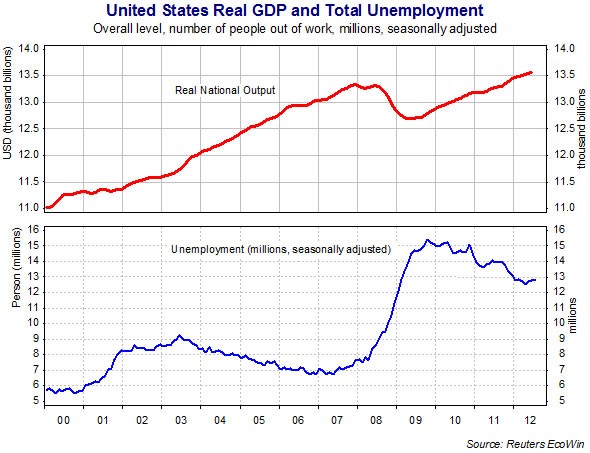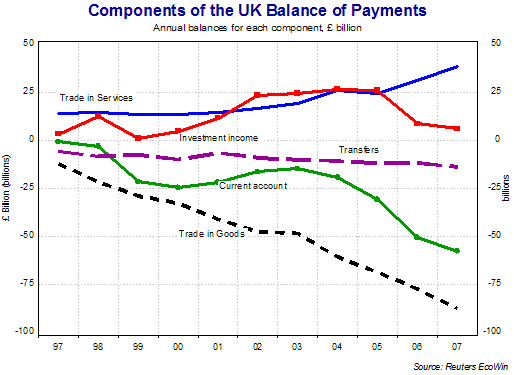Balance of Payments Economics Online Tutor
Post on: 16 Март, 2015 No Comment

Balance of payments is not the same thing as balance of trade.
Balance of payments: a record of a country’s trade with the rest of the world.
This record includes transactions involving accounts in goods, services, and
financial assets. Balance of trade involves only one such account, as
explained below. Balance of payments, by definition, must always be zero:
debits equal credits. Each transaction involves an equal amount of
something received and something given up. If someone mentions a surplus
or deficit in the balance of payments, they are really talking about something
The balance of payments is divided into two broad categories: the current
account, and the financial account.
The current account in turn is divided into four categories: the merchandise
account, the services account, the income account, and the unilateral
transfers account. Each of these accounts can carry a surplus or a deficit
balance, and so can their sum (the balance of the current account).
A brief description of each of these four accounts:
Merchandise account: transactions involving goods traded between countries. The export of a good
would be a positive (credit) entry in the merchandise account. The import of a good would be a
negative (debit) entry in the merchandise account. The merchandise account is important because
exports represent production for the domestic economy, while imports represent spending on goods
that are not part of domestic production. Exports represent activity within the economy, including jobs,
business creation, and economic growth. Imports represent goods that have been purchased from
potential competitors of domestic producers, which would mean a loss of jobs, business, economic
growth.
This is important politically, especially when the political concern is loss of jobs and business within
specific sectors of the economy (such as manufacturing), or entire industries.
This political concern is one of the main considerations whenever trade barriers are being considered.
On the other hand, imports represent goods that can be produced more efficiently elsewhere, so that
domestic resources can be re-allocated to more efficient uses. This re-allocation of resources means
that the overall economy can produce more with the same amount of resources. The result is more, not
less, jobs, business, and economic growth. See the section on specialization and trade for an
explanation of this concept.
So, the merchandise account is an example of economic forces that decrease economic activity in one
sense while increasing economic activity in another sense. How a person interprets this discrepancy
will likely influence which policies that person will support.
Balance of trade usually refers to the balance in the merchandise account.
Services account: transactions between countries involving services. This account includes tourism
and transaction costs, such as transportation costs for merchandise transactions.
Income account: transactions involving income between countries. Investment income and wages
earned in another country is a positive (credit). Investment income and wages earned from domestic
activity by foreigners would be a negative (debit).
Unilateral transfers account: transactions between countries in which only one country actually
receives something. This would include gifts and pensions. This account has political implications,
especially regarding immigration policy. A foreign national who earns money in the domestic economy
but sends some of the money earned to family members in another country would be creating a
negative (debit) in the unilateral transfers account.
The merchandise account comprises by far the largest portion of the current account. For this reason,
the current account balance and the merchandise account balance are both sometimes referred to as
the balance of trade. Recall that the very beginning of this page mentioned that the balance of
payments is not the same thing as the balance of trade. This is why.

Recall that the balance of payments includes both the current account and the financial account. The
financial account represents the flow of money between countries. It basically includes the other side
of the entries in the current account. For example, exports would mean that goods are transferred out
of the country, but an equal value of money is transferred into the country. The flow of goods would be
reflected in the current account while the flow of money would be reflected in the financial account.
Every transaction involves an equal value of credits and debits. This means that if either the current
account or the financial account reflects a surplus, the other one must reflect a deficit of the same
amount.
What all of this means in terms of GDP, debt, and political implications:
Recall that when calculating GDP, exports are added and imports are
subtracted. Exports represent production that is produced domestically
but not consumed domestically. Imports represent domestic consumption
that does not add to production, so imports have to be subtracted when
computing GDP in order to reflect production.
When the value of exports and imports are not equal, then consumption
does not equal production. The difference between the two represents
borrowing. If imports are greater than exports, represented by a debit
balance in the current account and a credit balance in the financial
account, then the country is a net debtor nation. It borrows more money
from the rest of the world than it loans to the rest of the world. If exports
are greater than imports, the country is a net creditor nation. This has
political implications, as debt implies money owed.
A trade deficit is not the same thing as the national debt, although
politicians often imply that it is. A trade deficit is a net debit in the current














